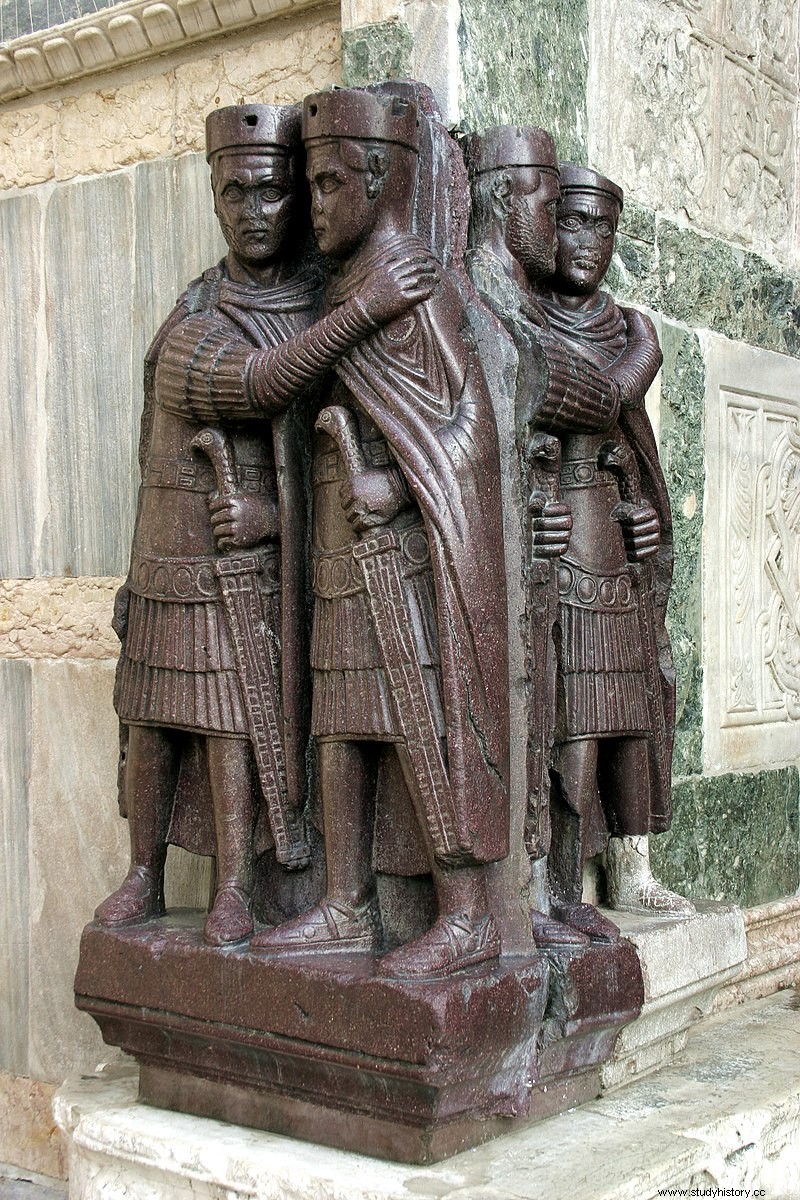
The era of military emperors continued, with as many as 25 emperors dying in the 50th century of the Roman sect, which was said to be the third century of the crisis.
Diocletian, the last military emperor who put an end to it, decided that it was impossible to rule the vast Rome with the power of one emperor, and initially in the two-headed system (Dialkia) with Maximian, the Roman Empire Was divided and governed, but even that became difficult.
Therefore, Diocletian placed a deputy emperor (Caesar) in addition to the orthodox emperor (Augustus) and started the four-division rule (Tetrarchy) by four emperors.
Governance by four emperors

Tetrarchy under Diocletian is as follows.
Empire Touhou Orthodox (Syria):Diocletian
Empire Eastern Deputy Empire (towards the Donau River):Emperor Galleriaus
Empire West Orthodox (North Africa, Rome):Maximian
Empire West Deputy Empire (towards the Rhine):Constantinople
At that time, Rome was in a state where the Sasanian Persia to the east and Germanic people from the north crossed the Rhine and Donau rivers and invaded the territory, and organized bandits were striding.
In particular, there are cases where the commander class of the former corps organizes bandits, and it can be said that the restoration of security and the restraint against foreign enemies were the most important tasks.
In Dominates by Emperor Diocletian, the idea of local autonomy under Principate was abandoned, and the emperor's power, that is, the centralized system, was transferred. And it can be said that it was a large-scale bureaucracy that supported it.
The idea of a province and its Governor-General was abandoned, the Senate was virtually out of service, and the tax rate had to be raised significantly because of the enormous cost of maintaining a bureaucracy.
The reason why the rebellion did not occur is probably that the security was greatly restored. Bandits, bandits, and pirates that nest in various parts of the country have been subdued, and in fact, no foreigners have invaded Roman territory since the beginning of Tetrarchy.
The collapse of Tetrarchy and the civil war

Even if it is called a four-division rule, the reality is the tyranny of Emperor Diocletian.
The reason why such reforms were achieved at once is probably because of the execution power and charisma of Emperor Diocletian.
Perhaps he thought that had already been achieved, Diocletian stepped down from the throne with Maximian and retired for the first time in Roman emperor history.
Tetrarchy after the retirement of Diocletian is as follows.
Empire Touhou Masaru:Gallerianus
Empire Eastern Deputy Empire:Maximinus Daza
Empire Western Empire:Constantius Chlorus
Empire West Vice Empire:Caesar
This regime, however, did not last for years.
Dissatisfied with Tetrarchy and the Dominated system, Roman citizens and the Senate nicknamed the emperor, carrying out his father, Maximian, in connection with Maxentius, who had inherited the emperor's blood but was not nominated as a successor. Immediately after Emperor Constantine died of illness, his son, Emperor Constantine, also nicknamed the Roman emperor in the west.
Emperor Gallerianus, who was ranked first in the hierarchy, approved Constantine as a deputy emperor, and when he promoted Caesar, the western deputy emperor, to the emperor, he headed for the subjugation of his predecessor Maximian.
However, Severus was defeated in the battle with Emperor Maximian and died in the war.
Taking this as an opportunity, Constantine headed to Rome, first defeating Emperor Maximian, then defeating his son Maxentius at the Battle of the Miltia Bridge, where Maxentius was killed in action.
The remaining Emperor Licinius and Emperor Constantine meet in Milan, where the famous Edict of Milan is issued.
However, in 324 AD, Constantine also killed the surviving Emperor Licinius, making him the only Roman emperor.
Thinking about Tetrarchy
There are other examples in world history of governing a vast empire by division, but it has never worked.
After the death of Genghis Khan, the Mongol Empire also fought among his descendants, and the vast empire was divided into four and eventually declined.
A country where charisma has risen is good when charisma is alive, but when charisma leaves, it is fragile and collapses.
Rome after the death of Diocletian experienced a fierce civil war, and after the death of Emperor Constantine, Rome became an ugly battle.
Rome, which was a royal system, moved to a republican government, and from the former head of state, which respected the Senate, to a tyranny, and eventually to destruction.
A must-have for the prosperous.
Nevertheless, the Byzantine Empire kept its lifeline until the destruction of the Ottoman Empire in 1453. It was eventually passed on to the Romanov dynasty of Russia, which continued until the Russian Revolution of 1919.
